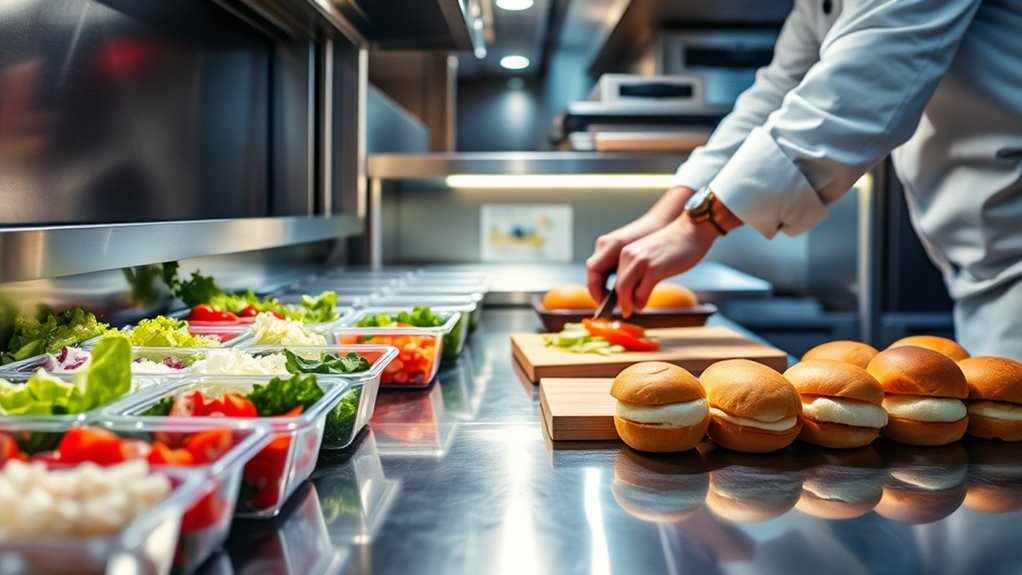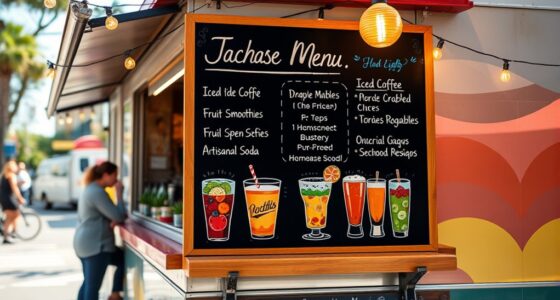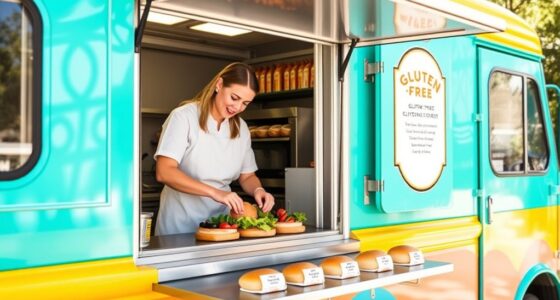To develop a successful food truck menu, focus on creating simple, efficient recipes that use versatile ingredients for speed and consistency. Optimize your packaging for transportation to keep dishes fresh and intact. Prioritize quick-cooking methods and batch prep to reduce wait times. Incorporate seasonal, cost-effective ingredients, and be mindful of dietary needs and allergies. For reliable, tasty results that appeal to customers, there’s more to explore in crafting a well-rounded menu.
Key Takeaways
- Simplify recipes to ensure quick prep, consistency, and easy sourcing of reliable ingredients.
- Choose ingredients and cooking methods that allow for rapid preparation and versatile menu options.
- Optimize packaging and presentation to maintain food quality during transit and enhance customer experience.
- Implement efficient mise en place and ingredient management to speed up service and reduce errors.
- Incorporate seasonal, local, and dietary options to control costs, meet dietary needs, and keep the menu fresh and appealing.
Prioritize Simplicity and Efficiency in Recipes

To create successful recipes, you should prioritize simplicity and efficiency from the start. Focus on ingredient sourcing that’s straightforward and reliable, ensuring you can quickly restock essential items without delays. Streamlining your recipes reduces prep time and minimizes errors, which is vital for a food truck’s fast-paced environment. Additionally, align your recipes with your branding strategies by choosing familiar flavors and presentation styles that resonate with your target audience. This consistency helps build recognition and loyalty. Avoid overly complex techniques or ingredients that slow down service, and instead, refine recipes to be easy to prepare and serve. Efficient recipes not only improve turnaround times but also reinforce your brand’s reputation for quality and reliability.
Focus on Portability and Ease of Transportation

To guarantee your recipes travel well, focus on compact packaging solutions that are easy to carry. Handle your containers with care to prevent spills or damage during transit. Always prioritize maintaining food integrity so your dishes arrive fresh and intact. Additionally, selecting self-watering containers can help keep your ingredients fresh and properly hydrated during transportation.
Compact Packaging Solutions
When designing packaging solutions, prioritizing portability and ease of transportation can substantially enhance product appeal and user convenience. Using sustainable packaging and eco-friendly materials helps reduce your environmental impact while ensuring your food stays fresh and intact. Compact packaging should be lightweight yet sturdy, making it easy for customers to carry and transport. Consider options like foldable containers or stackable boxes that save space. The right packaging not only protects your food but also boosts brand perception. Here’s a quick comparison:
| Feature | Benefit |
|---|---|
| Eco friendly materials | Appeals to eco-conscious customers and reduces waste |
| Compact design | Simplifies transportation and storage |
| Reusable options | Cost-effective and environmentally sustainable |
| Lightweight construction | Eases carrying and handling for customers |
Incorporating fan culture principles such as community engagement and brand loyalty can also help strengthen your customer base and encourage repeat business.
Handle With Care
Ensuring your packaging handles are designed with care can considerably improve portability and ease of transportation. When handling delicacies, sturdy and well-designed handles prevent spills and damage during transit. Proper handling minimizes the risk of crushing or deforming fragile items, especially when managing ingredients that require gentle treatment. Use secure, ergonomic handles that allow you to carry multiple containers comfortably. Consider how the packaging supports stability and balance, reducing the chance of accidents on the move. Additionally, choose materials that withstand movement without tearing or leaking. By focusing on these details, you ensure your food stays intact and presentable, making your service more efficient. Incorporating vetted packaging options ensures durability and safety during transportation. Handling delicacies with thoughtful packaging ultimately boosts customer satisfaction and streamlines your food truck operations.
Maintain Food Integrity
Careful packaging not only protects your food during transit but also helps maintain its integrity and quality. To keep your dishes appealing, focus on how well they hold up during transport, emphasizing food presentation and ingredient sourcing. Choose containers that prevent spillage and preserve textures, ensuring each dish looks fresh upon arrival. Proper packaging also minimizes messes and waste, making your food more portable. Consider this table for tips:
| Packaging Tip | Why It Matters |
|---|---|
| Airtight containers | Keeps food fresh and prevents leaks |
| Insulated carriers | Maintains temperature and presentation |
| Separate compartments | Prevents ingredients from mixing |
Using industry-standard packaging can further elevate your food truck’s professionalism and customer satisfaction.
Use Versatile Ingredients for Multiple Dishes

Using versatile ingredients can substantially streamline your recipe development process. When selecting ingredients, focus on items that work well across multiple dishes, simplifying inventory and prep. Think about ingredient pairings and flavor combinations that complement various recipes—such as grilled chicken, roasted vegetables, or versatile grains like rice or quinoa. These ingredients can serve as the base for salads, wraps, bowls, or tacos, saving you time and money. By choosing adaptable ingredients, you also create opportunities for creative variations without starting from scratch each time. This approach helps you build a flexible menu that appeals to diverse tastes while maintaining efficiency. Incorporating a rustic or vintage aesthetic into your food truck branding and decor can also enhance the overall customer experience. Ultimately, using versatile ingredients enhances consistency and reduces waste, making your food truck operations smoother and more profitable.
Incorporate Cost-Effective and Seasonal Items

Incorporating cost-effective and seasonal items into your menu allows you to maximize your budget while offering fresh, appealing dishes. Seasonal produce is often more affordable and readily available, helping you reduce costs without sacrificing quality. Focus on local ingredients that are in peak season, as they tend to be more flavorful and versatile. Use budget-friendly options like root vegetables, greens, and seasonal fruits to create diverse menu items. These ingredients not only keep costs down but also add variety and freshness to your offerings. By planning around what’s in season, you can develop dishes that highlight natural flavors and appeal to customers seeking fresh, affordable options. Understanding how to brew coffee effectively can also inspire creative beverage pairings that enhance your menu’s appeal. This approach keeps your menu sustainable, cost-efficient, and appealing year-round.
Optimize for Quick Preparation and Cooking Times

To save time in the kitchen, focus on streamlining ingredient prep by chopping and measuring everything ahead. Choose fast-cooking items like thin cuts of meat or pre-washed vegetables, and use efficient cooking methods such as sautéing or pressure cooking. These steps help you prepare delicious meals quickly without sacrificing quality. Additionally, understanding how to properly shift gears smoothly on a gravel bike can improve your efficiency and control during busy service hours.
Streamline Ingredient Prep
Preparing ingredients efficiently can substantially cut down your cooking time. To streamline ingredient prep, organize your workspace so everything is within reach, reducing unnecessary movement. Pre-measure spices, sauces, and other small ingredients beforehand to speed up assembly. Use uniform cuts for vegetables and proteins to ensure quick, even cooking. Batch prep ingredients in advance, storing them properly to save time during service. Consistent food plating techniques not only enhance presentation but also speed up plating, reinforcing your menu branding. Keep your mise en place tidy and labeled; this minimizes errors and delays. Incorporating mise en place principles into your workflow allows for smoother, more efficient service. By optimizing prep, you’ll serve dishes faster, maintain quality, and impress customers with quick turnaround times—all critical for a successful food truck operation.
Select Fast-Cooking Items
Choosing ingredients that cook quickly can substantially reduce your overall prep and cooking time. Focus on items like thin cuts of meat or vegetables that can be fast-cooked, avoiding slow roasting or lengthy processes. Quick-cooking proteins, such as shrimp or chicken strips, help keep service smooth. Also, select ingredients that require minimal handling, so you can avoid intricate plating that takes extra time. This ensures your food truck stays efficient, especially during busy hours. Keep in mind that some dishes may look more appealing with slow roasting or elaborate presentation, but for quick turnaround, prioritize speed over complex plating. By choosing fast-cooking items, you streamline your operation, serve fresh food faster, and keep your customers satisfied without sacrificing quality. Additionally, understanding best anime movies can inspire creative presentation ideas that captivate customers and enhance the overall dining experience.
Use Efficient Cooking Methods
Using efficient cooking methods can substantially cut down your preparation time and improve overall workflow. Techniques like sous vide ensure even cooking with minimal hands-on effort, allowing you to prepare items ahead of time. Flash freezing helps preserve ingredients, reducing prep during busy hours. To optimize, consider these approaches:
- Use sous vide for tender, pre-cooked proteins ready to reheat
- Implement flash freezing to store prepped ingredients efficiently
- Opt for pressure cooking to speed up tough cuts
- Utilize high-heat methods like stir-frying for quick meals
- Pre-cook and portion ingredients for rapid assembly
- Incorporating cooking methods like pressure cooking and stir-frying, as seen in vehicle tuning upgrades such as turbochargers and ECU remapping, can significantly enhance efficiency and performance in your kitchen.
Ensure Recipes Are Consistent and Reproducible

To guarantee your recipes turn out the same every time, focus on precise measurements and consistent techniques. Use a reliable scale for ingredient sourcing to ensure accuracy in each batch. Document your methods, including cooking times and temperatures, so you can replicate results easily. Pay close attention to flavor balancing by tasting and adjusting seasonings consistently. Keep your ingredients fresh and sourced from trusted suppliers to maintain quality and flavor. Establish standard procedures for prep and cooking, which helps minimize variability. Consistency is key to building customer trust and streamlining your operations. By controlling variables and sticking to proven methods, you’ll create dependable recipes that showcase your food truck’s signature flavors every time.
Consider Dietary Preferences and Allergies

Considering dietary preferences and allergies is essential for creating inclusive menu options that appeal to a wider audience. You should identify common allergies like gluten, nuts, and dairy, and offer alternatives to accommodate them. For example, include gluten-free options that use rice or corn-based ingredients. Make vegan modifications by substituting plant-based proteins and dairy-free sauces. To enhance customer satisfaction, consider:
- Clearly labeling gluten-free options
- Offering vegan modifications for popular dishes
- Avoiding cross-contamination during preparation
- Providing allergen information on menus
- Regularly updating ingredient lists to reflect new options
- Incorporating active listening to better understand customer needs and preferences.
Test Recipes in Real-World Conditions

Once you’ve developed your recipes with dietary restrictions and allergen considerations in mind, it’s time to see how they perform outside the test kitchen. Take your recipes out for a test run in real-world conditions, paying close attention to ingredient sourcing. Fresh, quality ingredients can impact flavor and consistency, so source locally when possible to guarantee freshness and manage costs. Observe how your dishes hold up during busy hours and in varying weather conditions. This real-world testing helps you refine cooking times, portion sizes, and ingredient stability. Additionally, consider your marketing strategies by showcasing the quality and sourcing of ingredients to attract customers. Testing recipes in actual conditions ensures your menu is reliable, appealing, and ready to impress in the competitive food truck scene. Incorporating insights from local regulations and permits can also help ensure compliance and smooth operations during testing.
Gather Customer Feedback for Continuous Improvement

Gathering customer feedback is essential for refining your recipes and enhancing the overall dining experience. Listening to your customers helps identify what works and what needs improvement, fueling effective menu refinement. To gather valuable insights:
- Use comment cards or digital surveys at your truck
- Encourage direct conversations during service
- Monitor online reviews and social media feedback
- Offer incentives for detailed feedback
- Observe customer reactions and preferences in real-time
- Recognize that continuous feedback can lead to better menu choices and increased customer satisfaction which can positively impact your business growth.
Frequently Asked Questions
How Can I Ensure My Recipes Stand Out From Competitors?
To make your recipes stand out from competitors, focus on creating unique flavor combinations that surprise and delight customers. Use fresh ingredients and bold spices to develop signature dishes. Pair this with creative presentation—think colorful garnishes or innovative plating—to catch the eye. Consistently offering memorable, visually appealing dishes will help your food truck attract loyal fans and distinguish you in a competitive market.
What Are the Best Methods for Pricing My Menu Items?
Thinking of pricing like balancing a tightrope, you need steady footing. You start with ingredient sourcing costs, ensuring they fit your target profit margin. Then, explore pricing strategies like value-based or competitive pricing to attract customers. For example, I once adjusted my menu prices after analyzing ingredient costs, which helped boost sales without sacrificing quality. This approach keeps your prices fair, competitive, and profitable.
How Do I Handle Ingredient Shortages or Substitutions?
When facing ingredient shortages or substitutions, you should stay flexible and use substitution strategies that maintain dish quality. Keep an eye on your inventory challenges and be ready to adapt recipes with available ingredients. Communicate clearly with your team, and consider creative alternatives that still satisfy customer expectations. This approach helps you manage shortages smoothly, ensuring your menu stays appealing and consistent despite supply hiccups.
What Marketing Strategies Complement My Food Truck’s Menu?
You might think food is enough to draw crowds, but pairing it with smart marketing boosts your truck’s success. Use social media to showcase your menu, share daily specials, and engage with customers. Building customer loyalty through reward programs also encourages repeat visits. While your menu delights taste buds, these strategies guarantee your food truck stays top-of-mind, turning passersby into loyal patrons who spread the word and fuel your growth.
How Can I Manage Food Waste Effectively During Service?
To manage food waste effectively during service, focus on portion control to prevent excess leftovers. Implement composting strategies for unavoidable waste, like vegetable scraps and used napkins, reducing your environmental impact. Keep a close eye on inventory to avoid overordering, and train your staff to serve appropriate portions. This approach minimizes waste, saves money, and promotes eco-friendly practices, ensuring your food truck operates efficiently and sustainably.
Conclusion
By keeping your recipes simple, versatile, and efficient, you’ll set your food truck up for success. Focus on easy-to-transport ingredients and quick prep times to stay ahead of the game. Remember, it’s better to get your ducks in a row early on; consistency and real-world testing are key. Listen to customer feedback and adapt as needed—after all, a well-oiled machine runs smoothly and keeps customers coming back for more.









